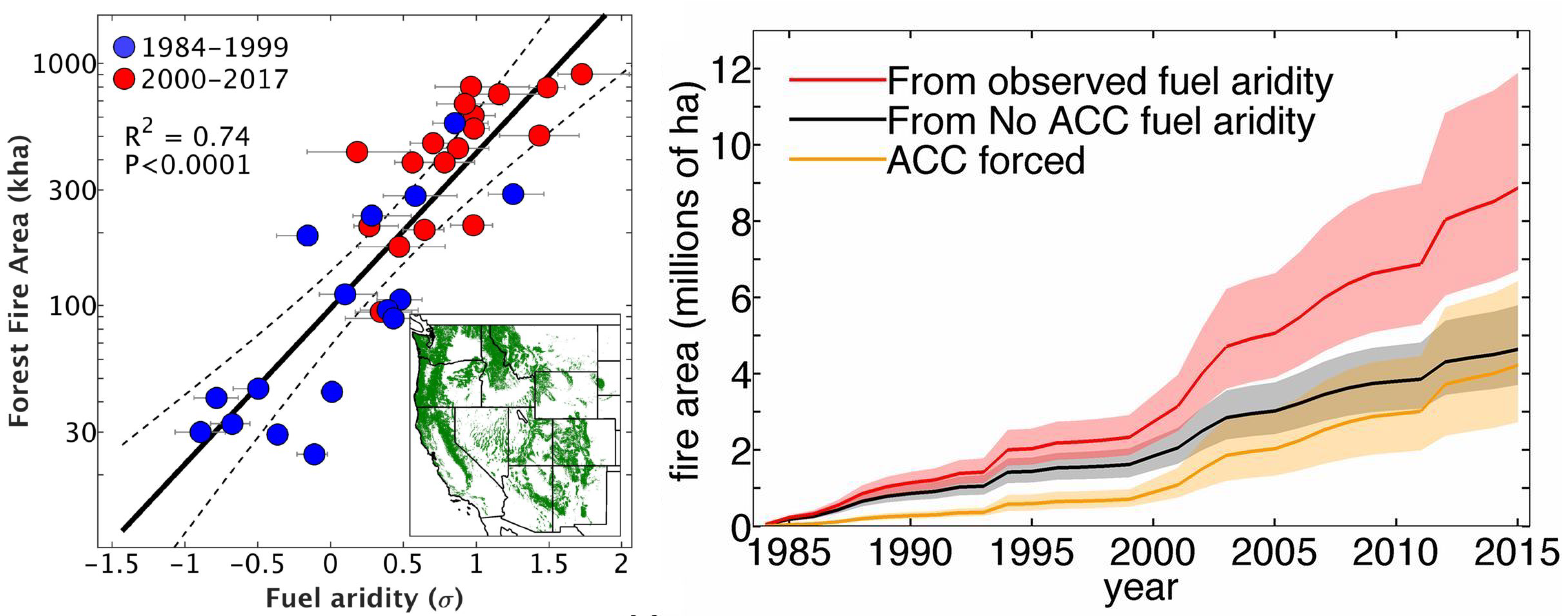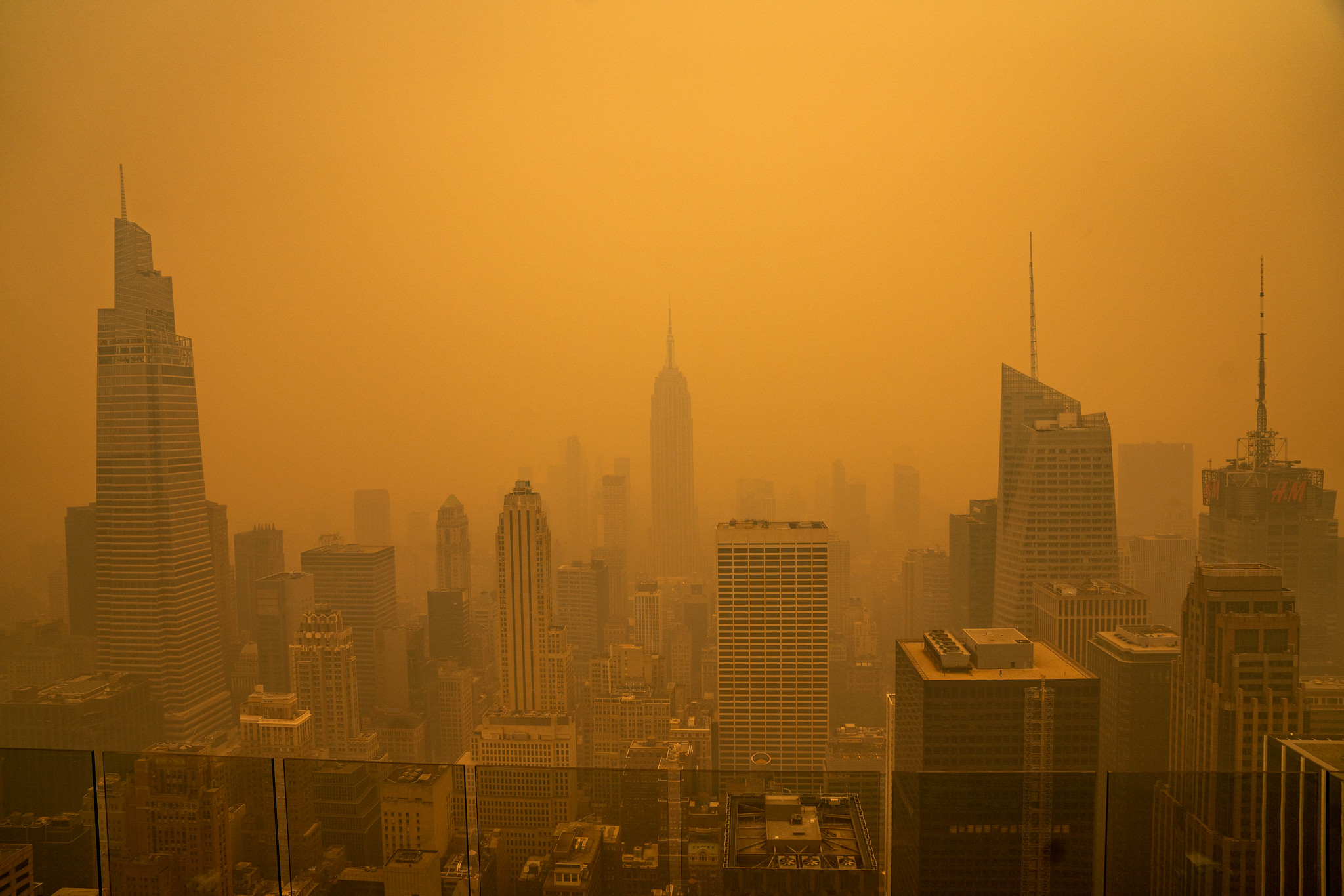
This past summer was the hottest ever recorded…again. As monthly heat records fell one by one worldwide, wildfires also became front-page news throughout 2023. From across North America, Greece, Chile, Algeria, and Kazakhstan among many others, wildfires burned uncontrollably. The striking orange New York City skyline was the result of Canadian wildfire smoke. Even now in October, Argentinians are currently fleeing a large wildfire that has spread due to strong winds and a heat wave. Summer as we know it is changing.
Within this warming world, is climate change to blame for the increases in wildfire frequency and intensity? Well, wildfires are complex and multifaceted like all natural phenomena. There’s much more than just one factor that contributes to wildfire frequency, spread, and duration. But in short, climate change is special: it’s the new wildfire enabler. This article explores some of the main wildfire factors, how they relate to climate change, and the increasing risk of the wildfire, climate, and human activity feedback loop.
The many factors driving wildfires
Fortunately, dropping a lit matchstick in the woods does not necessarily cause a large, uncontrolled wildfire. A complex interaction of biophysical and, at times, anthropogenic factors must first create the right conditions. A few transversal factors standout, namely anything associated with ignitions, fuels, droughts, and so-called “fire weather” conditions[1]. Wildfires occur at the nexus of many factors which closely overlap and interact to influence fire behaviour (Fig. 1).
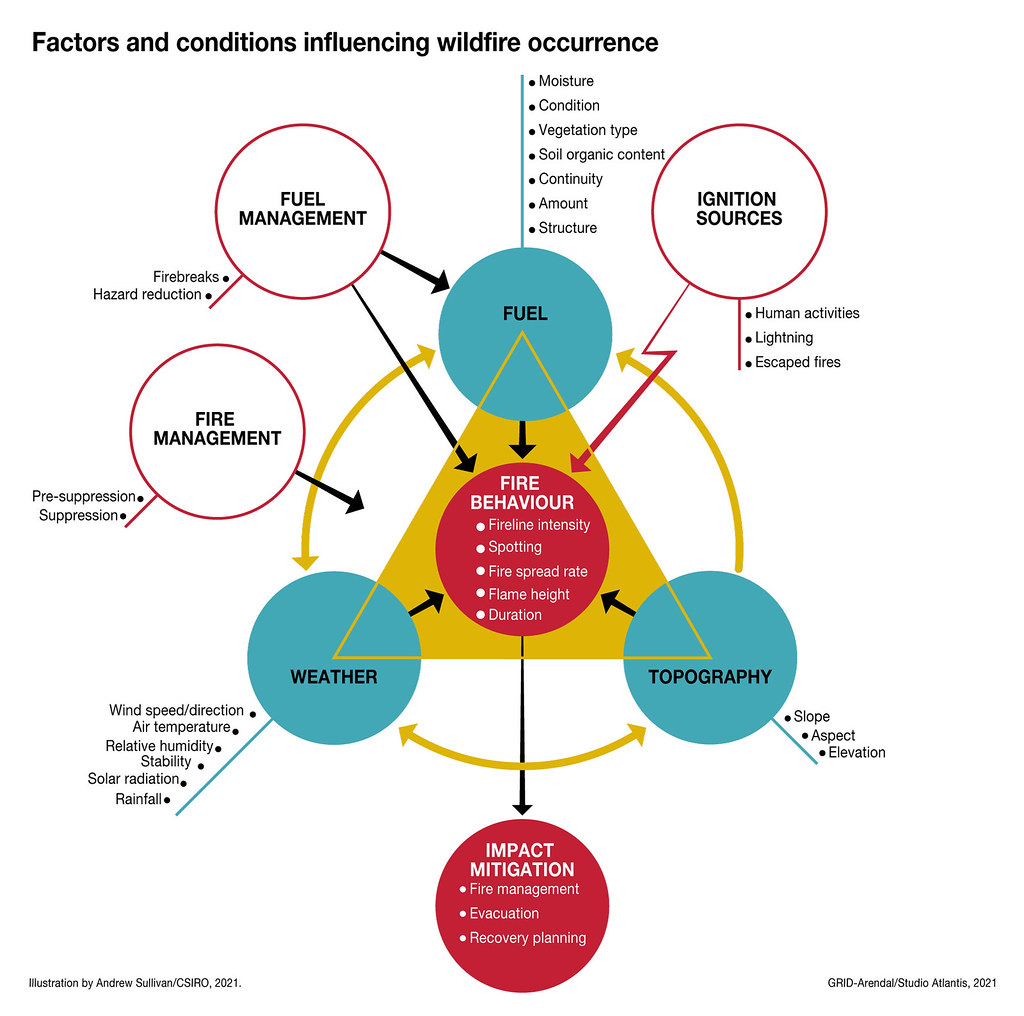
Figure 1 – Wildfires are driven by many complex factors which interact to shape the occurrence, behaviour, duration, spread, and overall impact of the fire. According to Pausas and Keeley (2021), there are four main transversal factors: ignitions, fuels, droughts, and weather conditions. Source: GRID-Arendal.
A wildfire can be ignited in different ways, either from natural causes like lightning strikes and volcanic activity, or from human causes like poor campfire management, discarded cigarettes, poorly managed slash-and-burn agriculture, arson, and so on. Wildfires also need a continuous supply of fuel to burn—the drier the better.
The quality and quantity of vegetation available to burn will determine the intensity of the wildfire. Drought dries vegetation and gives wildfires more opportunities to spread and survive by increasing available fuel sources. Fire weather conditions like temperature, humidity, wind speed and direction, and precipitation regimes influence the chance of a wildfire starting and its behaviour over time. In Indonesia, this year’s wildfire season is the worst it has been for several years because of the fire weather conditions produced with the natural return of the warm phase of the El Niño–Southern Oscillation.
Aside from these overarching factors, the local landscape topography and the level of human activity in the area add the final ingredients to the wildfire mix. The speed, direction, and coverage of a wildfire is dependent on the physical features in the area, such as mountains, valleys, and river beds. Terrain features can also modulate surface wind patterns, guiding fires through a landscape. Stable winds bring oxygen and help wildfires spread faster.
Opportunities for ignitions increase as population increases, especially at the wildland–urban interface[2]. But when it comes to humans, we do more than cause ignitions. We fragment burnable landscapes through intensive land use practices. Croplands and urban development slow wildfire spread. Conversely, in regions like the Mediterranean with high rates of forest regrowth on abandoned agricultural lands, wildfire risk rebounds[3]. Secondary succession on previously cleared lands reconnects burnable areas and provides new fuel sources[4].
The way we conduct fire prevention in vegetated areas is also critical. By preventing natural wildfires from burning through an area periodically, we also increase the chances for an uncontrolled megafire to occur unless built-up forest fuel is cleared and managed responsibly (e.g., through controlled burns).
Climate change is making wildfire thresholds easier to breach
Climate change affects long-term weather patterns, so it is directly linked to wildfire risk and has already led to more frequent and more severe wildfires. In the western United States for example, by increasing fuel aridity and drought events, climate change has drastically increased the size of wildfire burned areas in recent decades (Fig. 2.), with roughly 4.2 million hectares added (about the combined size of Massachusetts and Connecticut)[5].
Figure 2 – Left: The relationship between fuel aridity and annual forest fire area in the western US, with forest distribution (green) indicated in the insert. There was over a 3-fold increase in burned area between the periods 1984-1999 to 2000-2017[5]. Right: The impact of climate change (indicated here as anthropogenic climate change, ACC) on fuel aridity and forest fire area. The red indicates the observed forest fire area, the black indicates a simulated scenario without climate change, and the orange represents all the burned areas attributed to climate change (red minus black)[5].
Wildfires occur when the thresholds for ignition, fuel, and drought are breached and the weather conditions are appropriate. The duration of the fire season, and the frequency of drought and dry years are all increased by climate change, decreasing fire weather thresholds overall (Fig. 3). While climate change may not always be the most important factor in every specific wildfire location, its relative importance worldwide is increasing as the impacts of global warming intensify[1,6].
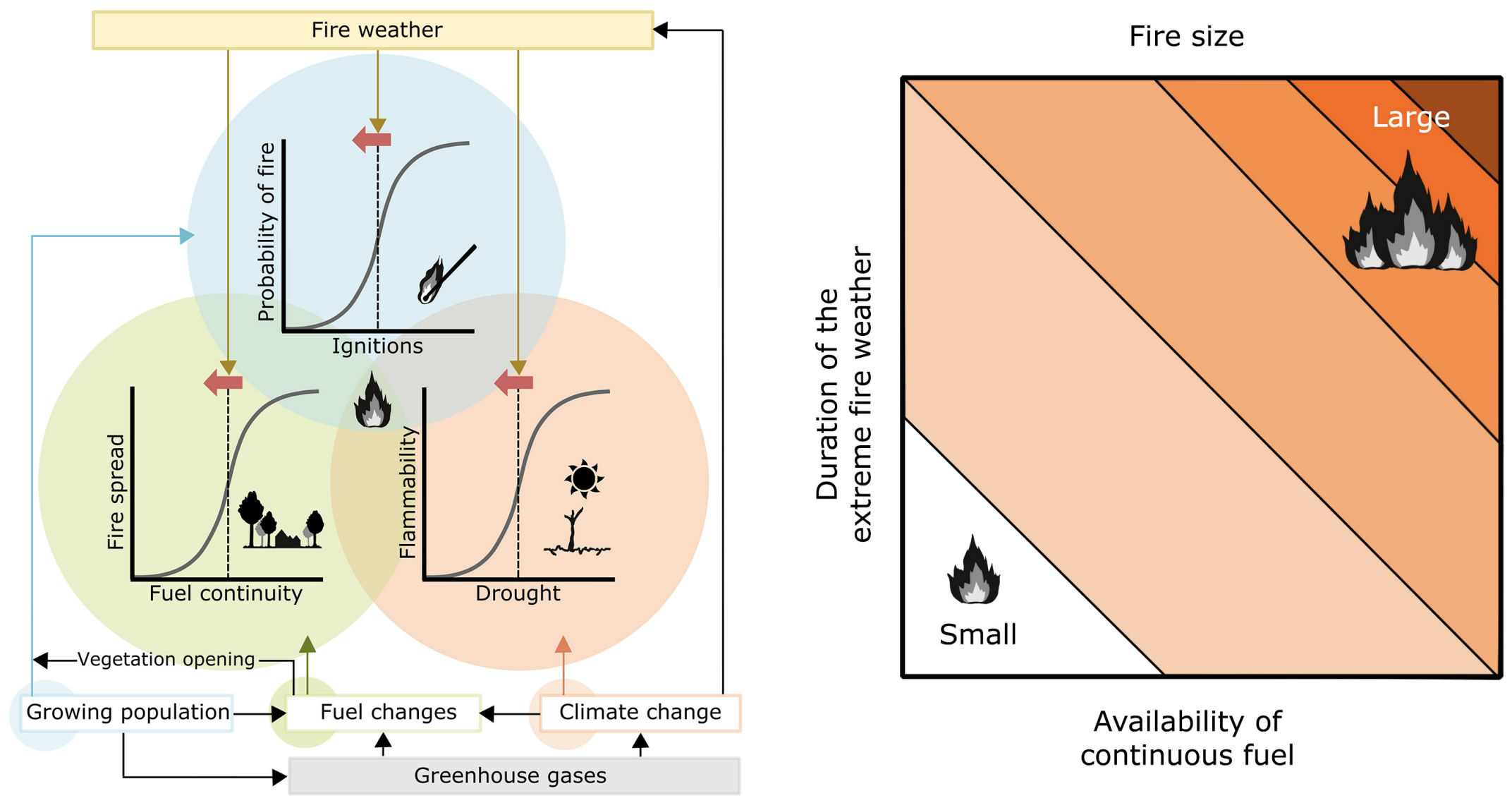
Figure 3 – Left: The shifting thresholds (dashed vertical lines) for key wildfire factors of ignitions, fuels, droughts. Human activities, represented here as “growing population” especially at the wildland-urban interface, and climate change are closely interconnected with these thresholds[1]. Right: Wildfires occur after these thresholds are breached, but the size and survival of the wildfire will depend on the fuel continuity and duration of the fire weather[1].
Wildfires are primarily ignited naturally from lightning, and climate change is even capable of increasing lightning strikes. Strikes over land are predicted to increase by 47% by the end of the century (RCP6.0 scenario)[7]. The rest of the ignitions are almost exclusively the result of human activity. Natural hazards like wildfires cause people to relocate, which expands the wildland-urban interface and increases the chances for new ignition events.
Although deforestation and rural development in formerly vegetated areas increases forest fragmentation, there is also an increase in fuel aridity and fuel availability. In the Amazon rainforest, where climate change is increasing mean temperature and the length of the dry season, the creation of open spaces for croplands and roads further dries out vegetation[8]. This has led to the Amazonian deforestation fires[9].
The extended drought seasons resulting from climate change give wildfires more opportunities to spread and survive by increasing fuel sources. Burned areas in wildfire risk zones like in Australia and the western US are increasing in tandem with the climate driven increases in drought and fire weather[10].
Invasive plant species that find favourable habitat conditions in new areas because of climate change can also influence wildfire events. For example, the 2020 Dome Fire in California’s Mojave Desert was made worse by the exotic grasses which filled the gaps of native vegetation and increased the quantity and the connectivity of the fuel[11]. Instead of the normally small patches of fires, there were larger concentrated fires.
The revegetation of agricultural landscapes because of land abandonment and other land use changes has resulted in millions of hectares of reconnected biomass (fuel)[12]. Global change processes are both greening (increase in vegetation and therefore fuel quantity) and browning (increase in vegetation dryness and therefore fuel aridity) the Earth[13]. Even the CO2 fertilisation effect from elevated greenhouse gases can increase wildfire risk by stimulating higher rates of plant biomass and litter production, thereby fuel loading burnable areas[14].
The wildfire-climate positive feedback loop
We now find ourselves in the middle of a positive feedback loop between wildfires, climate change and human activities (Fig. 4). As we emit more and more greenhouse gases and the Earth’s temperature rises[15], we create drier forests, milder winters, and longer fire seasons. These changes help wildfires spread farther and survive longer, increasing total burned area.
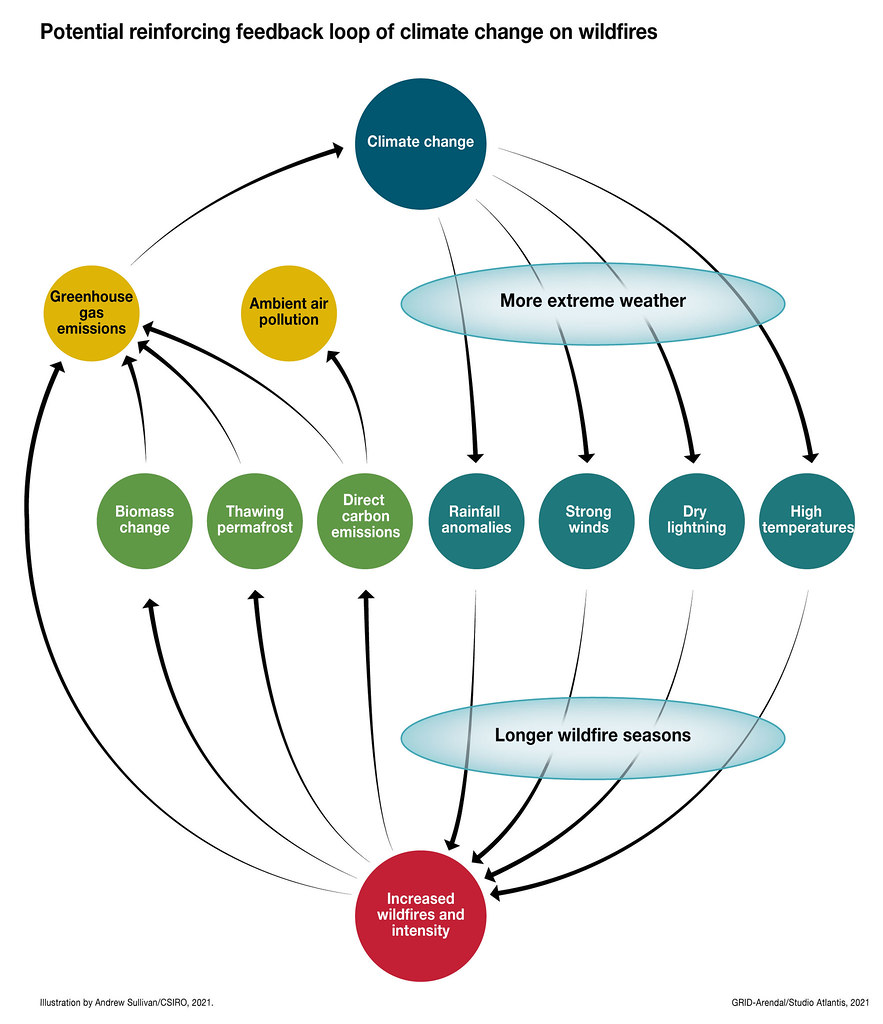
Figure 4 – The positive feedback loop between wildfires and climate change. Each component has the potential to reinforce each other, which is also intensified by human activities through greenhouse gas emissions. Source: GRID-Arendal.
Drier vegetation is also more easily ignited by natural and human causes, increasing wildfire events. With more and longer lasting wildfires, more biomass carbon is converted into greenhouse gases like carbon dioxide, methane, and nitrous oxide and transferred to the atmosphere.
Northern hemisphere forest fires are now emitting more carbon than ever before. Climate-wildfire feedbacks have helped drive extreme Boreal forest fires in North America and Eurasia, which in 2021 jumped from representing normally 10% of global fire emissions to nearly a quarter[16]. These elevated emissions combine with human emissions and complete the feedback loop by intensifying the greenhouse effect, increasing global temperatures, and drying out vegetation further.
Our ability to perform wildfire-counter measures, such as prescribed fires (i.e., controlled burns) to reduce fuel load and extreme wildfire hazard risk, is also being thwarted by climate change. To perform a prescribed fire, we need days with favourable temperature, relative humidity, wind, and vegetation moisture conditions to make sure the fire doesn’t burn out of control. The available days with these conditions are expected to reduce by 17% by 2060 under 2°C of warming[17].
In summary, it is important to remember that although there are multiple things at play when it comes to wildfires, climate change is becoming increasingly important. Wildfires are the result of complex interactions between biophysical and human factors, and it only takes one poorly managed campfire to cause a serious, widespread wildfire disaster. When well-known and studied causes of wildfires are found to be the original source of ignition, such as arson or downed power lines, they are sometimes used as arguments against climate change having any role at all. Many wildfires are indeed the direct result of human activities. However, many more and much worse wildfires are now possible because of climate change, leading to greater environmental and economic negative impacts[6].
REFERENCES
- [1] Pausas and Keeley (2021). Wildfires and global change. Frontiers in Ecology and the Environment.
- [2] Radeloff et al. (2018). Rapid growth of the US wildland-urban interface raises wildfire risk. PNAS.
- [3] Moreira et al. (2020). Wildfire management in Mediterranean-type regions: paradigm change needed. Environmental Research Letters.
- [4] Ursino and Romano (2014). Wild forest fire regime following land abandonment in the Mediterranean region. Geophysical Research Letters.
- [5] Abatzoglou and Williams (2016). Impact of anthropogenic climate change on wildfire across western US forests. PNAS.
- [6] Bowman et al. (2020). Vegetation fires in the Anthropocene. Nature Reviews Earth & Environment.
- [7] Pérez-Invernón et al. (2023). Variation of lightning-ignited wildfire patterns under climate change. Nature Communications.
- [8] Brando et al. (2019). Droughts, Wildfires, and Forest Carbon Cycling: A Pantropical Synthesis. Annual Review of Earth and Planetary Sciences.
- [9] Barlow et al. (2019). Clarifying Amazonia’s burning crisis. Global Change Biology.
- [10] Richardson et al. (2022). Global increase in wildfire potential from compound fire weather and drought. npj Climate and Atmospheric Science.
- [11] Keeley and Pausas (2019). Distinguishing disturbance from perturbations in fire-prone ecosystems. International Journal of Wildland Fire.
- [12] Næss et al. (2021). The land–energy–water nexus of global bioenergy potentials from abandoned cropland. Nature Sustainability.
- [13] Pausas and Millán (2019). Greening and Browning in a Climate Change Hotspot: The Mediterranean Basin. BioScience.
- [14] Ren et al. (2022). Projecting Future Fire Regimes in a Semiarid Watershed of the Inland Northwestern United States: Interactions Among Climate Change, Vegetation Productivity, and Fuel Dynamics. Earth’s Future.
- [15] IPCC (2021). Climate Change 2021: The Physical Science Basis. Contribution of Working Group I to the Sixth Assessment Report of the Intergovernmental Panel on Climate Change.
- [16] Zheng et al. (2023). Record-high CO2 emissions from boreal fires in 2021. Science.
- [17] Swain et al. (2023). Climate change is narrowing and shifting prescribed fire windows in western United States. Communications Earth & Environment.

